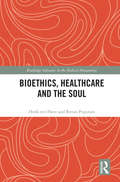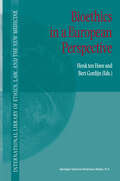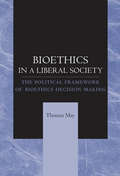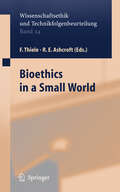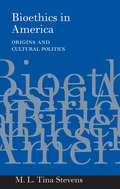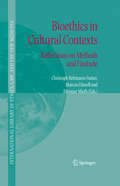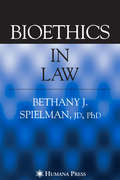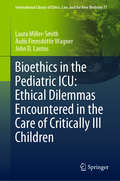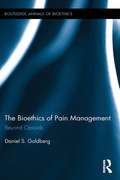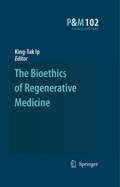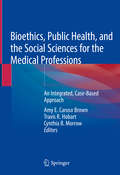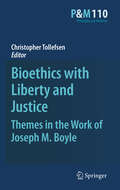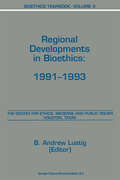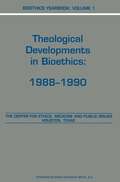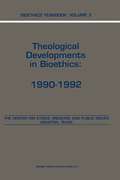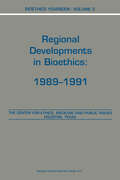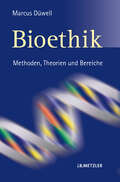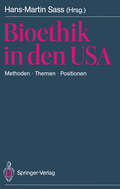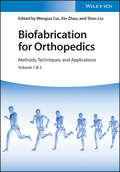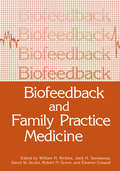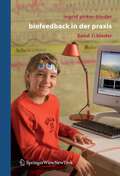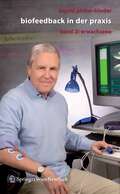- Table View
- List View
Bioethics, Healthcare and the Soul (Routledge Advances in the Medical Humanities)
by Henk ten Have Renzo PegoraroThis thought-provoking book explores the connections between health, ethics, and soul. It analyzes how and why the soul has been lost from scientific discourses, healthcare practices, and ethical discussions, presenting suggestions for change. Arguing that the dominant scientific worldview has eradicated talk about the soul and presents an objective and technical approach to human life and its vulnerabilities, Ten Have and Pegoraro look to rediscover identity, humanity, and meaning in healthcare and bioethics. Taking a mulitidisciplinary approach, they investigate philosophical, scientific, historical, cultural, social, religious, economic, and environmental perspectives as they journey toward a new, global bioethics, emphasizing the role of the moral imagination. Bioethics, Healthcare and the Soul is an important read for students, researchers, and practitioners interested in bioethics and person-centred healthcare.
Bioethics, Healthcare and the Soul (Routledge Advances in the Medical Humanities)
by Henk ten Have Renzo PegoraroThis thought-provoking book explores the connections between health, ethics, and soul. It analyzes how and why the soul has been lost from scientific discourses, healthcare practices, and ethical discussions, presenting suggestions for change. Arguing that the dominant scientific worldview has eradicated talk about the soul and presents an objective and technical approach to human life and its vulnerabilities, Ten Have and Pegoraro look to rediscover identity, humanity, and meaning in healthcare and bioethics. Taking a mulitidisciplinary approach, they investigate philosophical, scientific, historical, cultural, social, religious, economic, and environmental perspectives as they journey toward a new, global bioethics, emphasizing the role of the moral imagination. Bioethics, Healthcare and the Soul is an important read for students, researchers, and practitioners interested in bioethics and person-centred healthcare.
Bioethics in a European Perspective (International Library of Ethics, Law, and the New Medicine #8)
by H. A. Ten Have Bert GordijnThis book gives an overview of the most salient themes in present-day bioethics. The book focuses on perspectives typical for the European context. This highlights not only particular bioethical themes such as social justice, choices in health care, and health policy (e.g., in post-communist countries), it also emphasizes specific approaches in ethical theory, in relation to Continental philosophies such as phenomenology and hermeneutics.
Bioethics in a Liberal Society: The Political Framework of Bioethics Decision Making
by Thomas MayIssues concerning patients' rights are at the center of bioethics, but the political basis for these rights has rarely been examined. In Bioethics in a Liberal Society: The Political Framework of Bioethics Decision Making, Thomas May offers a compelling analysis of how the political context of liberal constitutional democracy shapes the rights and obligations of both patients and health care professionals. May focuses on how a key feature of liberal society—namely, an individual's right to make independent decisions—has an impact on the most important relational facets of health care, such as patients' autonomy and professionals' rights of conscience.Although a liberal political framework protects individual judgments, May asserts that this right is based on the assumption of an individual's competency to make sound decisions. May uses case studies to examine society's approach to medical decision making when, for reasons ranging from age to severe mental disorder, a person lacks sufficient competency to make independent and fully informed choices. To protect the autonomy of these vulnerable patients, May emphasizes the need for health care ethics committees and ethics consultants to help guide the decision-making process in clinical settings. Bioethics in a Liberal Society is essential reading for all those interested in understanding how bioethics is practiced within our society.
Bioethics in America: Origins and Cultural Politics
by M. L. StevensIn Bioethics in America, Tina Stevens challenges the view that the origins of the bioethics movement can be found in the 1960s, a decade mounting challenges to all variety of authority. Instead, Stevens sees bioethics as one more product of a "centuries-long cultural legacy of American ambivalence toward progress," and she finds its modern roots in the responsible science movement that emerged following detonation of the atomic bomb.Rather than challenging authority, she says, the bioethics movement was an aid to authority, in that it allowed medical doctors and researchers to proceed on course while bioethicists managed public fears about medicine's new technologies. That is, the public was reassured by bioethical oversight of biomedicine; in reality, however, bioethicists belonged to the same mainstream that produced the doctors and researchers whom the bioethicists were guiding.
Bioethics in Cultural Contexts: Reflections on Methods and Finitude (International Library of Ethics, Law, and the New Medicine #28)
by Christoph Rehmann-Sutter Marcus Düwell Dietmar MiethCHRISTOPH REHMANN-SUTTER, MARCUS DÜWELL, DIETMAR MIETH When we placed “finitude”, “limits of human existence” as a motto over a round of discussion on biomedicine and bioethics (which led to this collection of essays) we did not know how far this would lead us into methodological quandaries. However, we felt intuitively that an interdisciplinary approach including social and cultural sciences would have an advantage over a solely disciplinary (philosophical or theological) analysis. Bioethics, if it is to have adequate discriminatory power, should include sensitivity to the cultural contexts of biomedicine, and also to the cultural contexts of bioethics itself. Context awareness, of course, is not foreign to philosophical or theological bioethics, for the simple reason that the issues tackled in the debates (as in other fields of ethics) could not be adequately understood outside their contexts. Moral issues are always accompanied by contexts. When we try to unpack them – which is necessary to make them accessible to ethical discussion – we are regularly confronted with the fact that in removing too much of the context we do not clarify an issue, but make it less comprehensible. The context – at least some essential parts of it – is intrinsic to the issue. Unpacking in ethics is therefore a different procedure. It does not mean peeling the context off, but rather identifying which contextual elements are essential for an understanding of the key moral aspects of the issue, and explaining how they establish its particular character.
Bioethics in Law
by Bethany SpielmanThis groundbreaking volume is the first to analyze how and to what extent bioethics considerations influence today's judges. Previous books have attended to the law that governs bioethics problems, but this is the first to examine when and how bioethical issues impact judicial reasoning and decision-making. The volume examines the cutting-edge of the relationship of bioethics to law, and explores how law receives, assesses, and uses bioethics.
Bioethics in the Pediatric ICU: Ethical Dilemmas Encountered in the Care of Critically Ill Children (International Library of Ethics, Law, and the New Medicine #77)
by Laura Miller-Smith John D. Lantos Ásdís Finnsdóttir WagnerThis book examines the many ethical issues that are encountered in the Pediatric Intensive Care Unit (PICU). It supports pediatricians, nurses, residents, and other providers in their daily management of critically ill children with the dilemmas that arise. It begins by examining the evolution of pediatric critical care, and who is now impacted by this advancing medical technology. Subsequent chapters explore specific ethical concerns and controversies that are commonly encountered. These topics include how to conduct end-of-life discussions with families facing a myriad of challenging choices. It goes on to explore the concept of futility, and what that does and does not mean in the pediatric ICU setting. Controversial subjects such as children as organ donors, particularly using donation after cardiac death, in addition to issues surrounding the declaration of brain death are covered. Additional chapters address resource allocation, and also analyze the use of long-term technology in chronically critically ill children. Chapters include case examples with guidance on how to work through similar difficulties and decision-making. While this book is specifically targeted for care providers at the ICU bedside, it is also of benefit to medical students, students in bioethics, practicing ethical consultants and families who are dealing with critically ill children.
The Bioethics of Pain Management: Beyond Opioids (Routledge Annals of Bioethics)
by Daniel S. GoldbergIn this book, public health ethicist Daniel S. Goldberg sets out to characterize the subjective experience of pain and its undertreatment within the US medical establishment, and puts forward public policy recommendations for ameliorating the undertreatment of pain. The book begins from the position that the overwhelming focus on opioid analgesics as a means for improving the undertreatment of pain is flawed, and argues instead that dominant Western models of biomedicine and objectivity delegitimize subjective knowledge of the body and pain in the US. This general intolerance for the subjectivity of pain is part of a specific American culture of pain in which a variety of actors take part, including not only physicians and health care providers, but also pain sufferers, caregivers, and policymakers. Concentrating primarily on bioethics, history, and public policy, the book brings a truly interdisciplinary approach to an urgent practical ethical problem. Taking up the practical challenge, the book culminates in a series of policy recommendations that provide pathways for moral agents to move beyond contests over drug policy to policy arenas that, based on the evidence, hold more promise in their capacity to address the devastating and inequitable undertreatment of pain in the US.
The Bioethics of Pain Management: Beyond Opioids (Routledge Annals of Bioethics)
by Daniel S. GoldbergIn this book, public health ethicist Daniel S. Goldberg sets out to characterize the subjective experience of pain and its undertreatment within the US medical establishment, and puts forward public policy recommendations for ameliorating the undertreatment of pain. The book begins from the position that the overwhelming focus on opioid analgesics as a means for improving the undertreatment of pain is flawed, and argues instead that dominant Western models of biomedicine and objectivity delegitimize subjective knowledge of the body and pain in the US. This general intolerance for the subjectivity of pain is part of a specific American culture of pain in which a variety of actors take part, including not only physicians and health care providers, but also pain sufferers, caregivers, and policymakers. Concentrating primarily on bioethics, history, and public policy, the book brings a truly interdisciplinary approach to an urgent practical ethical problem. Taking up the practical challenge, the book culminates in a series of policy recommendations that provide pathways for moral agents to move beyond contests over drug policy to policy arenas that, based on the evidence, hold more promise in their capacity to address the devastating and inequitable undertreatment of pain in the US.
The Bioethics of Regenerative Medicine (Philosophy and Medicine #102)
by King-Tak IpRegenerative medicine is rich with promethean promises. The use of human embryonic stem cells in research is justified by its advocates in terms of promises to cure a wide range of diseases and disabilities, from Alzheimer’s and Parkinsonism to the results of heart attacks and spinal cord injuries. More broadly, there is the promethean allure of being able to redesign human biological nature in terms of the goals and concerns of humans. Needless to say, these allures and promises have provoked a wide range of not just moral but metaphysical reflections that reveal and reflect deep fault-lines in our cultures. The essays in this volume, directly and indirectly, present the points of controversy as they tease out the character of the moral issues that confront any attempt to develop the human regenerative technologies that might move us from a human to a post-human nature. Although one can appreciate the disputes as independently philosophical, they are surely also a function of the conflict between a Christian and a post-Christian culture, in that Christianity has from its beginning recognized a fundamental prohibition against the taking of early human life. Even the philosophical disputes that frame secular bioethics are often motivated and shaped by these background cultural conflicts. These essays display this circumstance in rich ways.
Bioethics, Public Health, and the Social Sciences for the Medical Professions: An Integrated, Case-Based Approach
by Amy E. Caruso Brown Travis R. Hobart Cynthia B. MorrowThis unique textbook utilizes an integrated, case-based approach to explore how the domains of bioethics, public health and the social sciences impact individual patients and populations. It provides a structured framework suitable for both educators (including course directors and others engaged in curricular design) and for medical and health professions students to use in classroom settings across a range of clinical areas and allied health professions and for independent study.The textbook opens with an introduction, describing the intersection of ethics and public health in clinical practice and the six key themes that inform the book's core learning objectives, followed by a guide to using the book. It then presents 22 case studies that address a broad spectrum of patient populations, clinical settings, and disease pathologies. Each pair of cases shares a core concept in bioethics or public health, from community perspectives and end-of-life care to medical mistakes and stigma and marginalization. They engage learners in rigorous clinical and ethical reasoning by prompting readers to make choices based on available information and then providing additional information to challenge assumptions, simulating clinical decision-making. In addition to providing a unique, detailed clinical scenario, each case is presented in a consistent format, which includes learning objectives, questions and responses for self-directed learning, questions and responses for group discussion, references, and suggested further reading. All cases integrate the six themes of patient- and family-centered care; evidence-based practice; structural competency; biases in decision-making; cultural humility and awareness of the culture of medicine; and justice, social responsibility and advocacy. The final section discusses some challenges to evaluating courses and learning encounters that adopt the cases and includes a model framework for learner assessment.
Bioethics with Liberty and Justice: Themes in the Work of Joseph M. Boyle (Philosophy and Medicine #110)
by Christopher TollefsenJoseph M. Boyle Jr. has been a major contributor to the development of Catholic bioethics over the past thirty five years. Boyle’s contribution has had an impact on philosophers, theologians, and medical practitioners, and his work has in many ways come to be synonymous with analytically rigorous philosophical bioethics done in the Catholic intellectual tradition. Four main themes stand out as central to Boyle’s contribution: the sanctity of life and bioethics: Boyle has elaborated a view of the ethics of killing at odds with central tenets of the euthanasia mentality, double effect and bioethics: Boyle is among the pre-eminent defenders of a role for double effect in medical decision making and morality, the right to health care: Boyle has moved beyond the rhetoric of social justice to provide a natural law grounding for a political right to health care; and the role of natural law and the natural law tradition in bioethics: Boyle’s arguments have been grounded in a particularly fruitful approach to natural law ethics, the so-called New Natural Law theory. The contributors to BIOETHICS WITH LIBERTY AND JUSTICE: THEMES IN THE WORK OF JOSEPH M. BOYLE discuss, criticize, and in many cases extend the Boyle’s advances in these areas with rigor and sophistication. It will be of interest to Catholic and philosophical bioethicists alike.
Bioethics Yearbook: Regional Developments in Bioethics: 1991–1993 (Bioethics Yearbook #4)
by B. AndrewLustignology in New Zealand. Angeles Tan Alora reports on the Code of Pharmaceutical Marketmg Practices developed by the Pharmaceutical and Health Care Association of the Philippines. Ruud ter Meulen and his colleagues provide detailed analysis of the Remmelink Commission's report on euthanasia in the Netherlands. Kazumasa Hoshino discusses the fmdings of the Special Committee on Gene Therapy in Japan. As such examples suggest, the activities of many governmental groups and professional advisory bodies, although varied, tend to converge upon a number of especially important issues. If one peruses the index of documents discussed in Volume Four, certain topics are more often the focus of legislation and official concern than others: withholding and withdrawing treatment, access to health care, consent to treatment and experimentation, and issues posed by HIV testing and AIDS. Such a common focus should not be exaggerated, for the discussion of topics is wide-ranging. But that commonality, when in evidence, is also not surprising. It suggests that key issues and concerns in bioethics may be widely shared among modern cultures and societies, for all the distinctiveness of a particular nation's or region's response to them. Issues of informed consent, after all, implicate more fundamental matters of respect for persons and the rights of individuals in the contexts of therapy and research. Issues of access to medical care concretize deeper questions about the nature and scope of a society's welfare obligations to its citizens.
Bioethics Yearbook: Theological Developments in Bioethics: 1988–1990 (Bioethics Yearbook #1)
by Thomas J. Bole Laurence B. McCullough H. TristramEngelhardt B. AndrewLustig Baruch A. BrodyAs the field of bioethics has matured, increasing attention is being paid to how bioethical issues are treated in different moral and religious traditions and in different parts of the world. It is often difficult, however, to get accurate information about these matters. The Bioethics Yearbook Series provides interested parties with analyses of how such issues as new reproductive techniques, abortion, maternal-fetal conflicts, care of seriously ill newborns, consent, confidentiality, equitable access, cost-containment, withdrawing treatment, active euthanasia, the definition of death, and organ transplantation are being discussed in these different traditions and different parts of the world. The first volume, and every second succeeding volume, will discuss developments in the Anglican, Baptist, Buddhist, Catholic, Eastern Orthodox, Hindu, Jewish, LDS, Lutheran, Methodist, Muslim, and Presbyterian Traditions. The second volume, and every second volume succeeding it, will discuss official governmental and medical society policies on these topics throughout the world.
Bioethics Yearbook: Theological Developments in Bioethics: 1990–1992 (Bioethics Yearbook #3)
by B. Andrew Lustig Baruch A. Brody H. Tristram Engelhardt Laurence B. McCulloughAs the field of bioethics has matured, increasing attention is being paid to how bioethical issues are treated in different moral and religious traditions and in different regions of the world. It is often difficult, however, to obtain accurate information about these matters. The Bioethics Yearbook series provides interested parties with analyses of how such issues as new reproductive techniques, abortion, maternal-fetal conflicts, care of seriously ill newborns, consent, confidentiality, equitable access, cost-containment, withholding and withdrawing treatment, active euthanasia, the definition of death, and organ transplantation are being discussed in different religious traditions and regions. Volume Three discusses theological developments from 1990--1992 in Anglican, Baptist, Buddhist, Catholic, Continental Protestant, Eastern Orthodox, Hindu, Jewish, Latter-Day Saint, Lutheran, Methodist, Muslim, and Presbyterian traditions. Volume Four will continue coverage of official governmental and medical society policies on these topics throughout the world.
Bioethics Yearbook: Regional Developments in Bioethics: 1989–1991 (Bioethics Yearbook #2)
by Laurence B. Mccullough H. TristramEngelhardt Baruch A. Brody B. AndrewLustigAs noted in Volume 1, the Yearbook series alternates between a biennial volume tracing recent theological discussions on topics in bioethics and a biennial volume tracing recent regional discussions in bioethics. Volume 2 provides for the first time a comprehensive single-volume summary of recent international and regional developments on specific topics in bioethics. To give uniformity to the discussions all authors were asked to report on the following topics: new reproductive technologies, abortion, maternal-fetal conflicts, case of severely disabled newborns, consent of treatment and experimentation, confidentiality, equitable access to health care, ethical concerns raised by cost-containment measures, decisions to withhold or withdraw life-sustaining treatment, active euthanasia, the definition of death, organ donation and transplantation. The internationally respected contributors report on the following 16 areas: the United States, Canada, Latin America, the United Kingdom and Ireland, France, the Netherlands, Germany/Austria/Switzerland, Eastern Europe, Spain/Portugal/Italy/Scandinavia, India, Southeast Asia, China, Japan, Australia/New Zealand, Council of Europe/EEC. The commentators draw on three sets of resources: Statutes, legislative proposals, and regulatory changes that directly influence, or have implications for, areas of bioethical concern; Case law and court judgments that shape, either decisively or suggestively, recent legal interpretations of particular issues of areas in bioethics; Formal statements of governmentally appointed commissions, advisory bodies, and representative professional groups, as well as less formal statements and recommendations of other organisations. In addition to providing timely summaries of recent developments, the volume offers rich and useful bibliographical references to a wide array of documents, many of which would be difficult for readers to learn about, given the lack of centralized international collection of such documents. The Yearbook should be widely consulted by all bioethicists, public policy analysts, lawyers and theologians.
Bioethik: Methoden, Theorien und Bereiche
by Marcus DüwellHeiß umstritten: Stammzell- und Embryonenforschung, Gentechnologie, Euthanasie. Was ist ethisch vertretbar? Marcus Düwell stellt die Diskussionen um die Grenzen menschlichen Handelns, um Leben und Natur und um den wissenschaftlichen Fortschritt auf ein philosophisches Fundament. Er erläutert Geschichte, Methoden und Begriffe der Bioethik und geht der Frage nach: Wie ist die veränderte Welt moralphilosophisch zu bewerten? Das Grundlagenwerk hilft bei der Orientierung.
Bioethik in den USA: Methoden · Themen · Positionen. Mit besonderer Berücksichtigung der Problemstellungen in der BRD
by R.M. Cook-Deegan H. T. Engelhardt R. Faden T. Pinkard H. M. Sass R. M. Veatch L. WaltersBiofabrication for Orthopedics: Methods, Techniques and Applications
by Wenguo Cui Xin Zhao Shen LiuBiofabrication for Orthopedics A comprehensive overview of biofabrication techniques for orthopedics and their novel applications With an ever-increasing global population and the rise in the occurrence of orthopedic diseases amongst an aging population, it is essential for technological advances to meet this growing medical need. Orthopedic biofabrication is a cutting-edge field that seeks to produce novel clinical solutions to this mounting problem, through the incorporation of revolutionary technologies that have the potential to not only transform healthcare, but also provide highly automated and personalized patient solutions. With the advances in the discipline, there is a significant growing interest in biofabrication for orthopedics in research activity geared towards routine clinical use. Ideal for a broad readership amongst medical practitioners and scientists, Biofabrication for Orthopedics summarizes all aspects of the topic: detailed information on the technology, along with advanced developments, research progress, and future perspectives on biofabrication for orthopaedics—particularly on the potential applications for tissue engineering technologies. In doing so, the book describes the various biomaterials—natural and synthetic—use for orthopedics and discusses the many ways in which these materials can be used in all parts of the body. As such, it offers detailed information on a wide range of applications in the fields of biology and clinical and industrial manufacturing. Biofabrication for Orthopedics readers will also find: Insights into the applications of biofabrication technologies in various bodily functions Thorough discussion of different biofabrication techniques used in creating orthopedic products, like stereolithography, cell sheet and organ bioprinting, electrospinning, and microfluidics Discussion of a wide range of diverse functions, such as bone implants, skin regeneration, vascularization, meniscus remodeling, and more Biofabrication for Orthopedics is a useful reference for those in a variety of research fields like medical-related practitioners and scientists, materials science, medicine, and manufacturing, as well as the libraries who support them.
Biofabrication for Orthopedics: Methods, Techniques and Applications
by Wenguo Cui Xin Zhao Shen LiuBiofabrication for Orthopedics A comprehensive overview of biofabrication techniques for orthopedics and their novel applications With an ever-increasing global population and the rise in the occurrence of orthopedic diseases amongst an aging population, it is essential for technological advances to meet this growing medical need. Orthopedic biofabrication is a cutting-edge field that seeks to produce novel clinical solutions to this mounting problem, through the incorporation of revolutionary technologies that have the potential to not only transform healthcare, but also provide highly automated and personalized patient solutions. With the advances in the discipline, there is a significant growing interest in biofabrication for orthopedics in research activity geared towards routine clinical use. Ideal for a broad readership amongst medical practitioners and scientists, Biofabrication for Orthopedics summarizes all aspects of the topic: detailed information on the technology, along with advanced developments, research progress, and future perspectives on biofabrication for orthopaedics—particularly on the potential applications for tissue engineering technologies. In doing so, the book describes the various biomaterials—natural and synthetic—use for orthopedics and discusses the many ways in which these materials can be used in all parts of the body. As such, it offers detailed information on a wide range of applications in the fields of biology and clinical and industrial manufacturing. Biofabrication for Orthopedics readers will also find: Insights into the applications of biofabrication technologies in various bodily functions Thorough discussion of different biofabrication techniques used in creating orthopedic products, like stereolithography, cell sheet and organ bioprinting, electrospinning, and microfluidics Discussion of a wide range of diverse functions, such as bone implants, skin regeneration, vascularization, meniscus remodeling, and more Biofabrication for Orthopedics is a useful reference for those in a variety of research fields like medical-related practitioners and scientists, materials science, medicine, and manufacturing, as well as the libraries who support them.
Biofeedback and Family Practice Medicine
by EleanorCriswell Robert N. Grove David W. Jacobs Jack H. Sandweiss William H. RicklesDuring the past five years there has been a reawakening of interest in the psychotherapy of patients with medical disorders characterized as psychosomatic. For three decades, psychoanalysis and psychoanalytic psychotherapy were used extensively to treat and study psychosomatic disorders. Early in the 1960s, interest in this approach to these conditions faded, and the ·Psychosomatic Service· in most hospitals became the ·Consultation Liaison Service· (Lipowski, 1967). The recent focus of biofeedback on psychosomatic conditions provides a new technique with which the physician or psychiatrist may treat these patients (Rickles, 1981). In addition, the successful application of biofeedback training to a variety of complaints such as those presented in this volume has heralded the addition of biofeedback to the treatment modalities used for medical complaints. Frequently, psychological factors can still be seen; for example, when biofeedback treatment may require lifestyle changes on the part of the patient, the exploration of secondary gains or resistances before the disorder can be success fully treated, and the establishment of rapport and empathy which is so important for truly effective biofeedback training. Aside from certain psychological dimensions that are always present in biofeed back training, in this case biofeedback is being used in a primarily medical setting for primarily medical complaints.
Biofeedback in der Praxis: Band 1: Kinder
by Ingrid Pirker-BinderGefühle wie Stress, Angst oder Freude verändern Herzrate, Atmung, Muskelspannung, Fingertemperatur und Hautleitwert. Biofeedback zeigt dies und fördert so die Selbstwahrnehmung und das Verständnis eigener Reaktionen. Kinder erlernen die Methode sehr schnell. Erstmalig bespricht dieses Buch wie sie auf Kinder angewendet werden kann. So z.B. beim Stressmanagement in Kindergarten oder Schule, bei Traumatisierungen, ADHD, ADD und in der Psychosomatik. Schritt für Schritt erklärt: das Therapiekonzept ASTI® für multimodales Biofeedback. Mit zahlreichen Übungsgeschichten: ein gelungenes Praxisbuch für Therapeuten, Trainer, Ärzte, Lehrer und Eltern.
Biofeedback in der Praxis: Band 2: Erwachsene
by Ingrid Pirker-BinderBiofeedback zeigt, wie der menschliche Körper auf Stress, Angst oder Freude durch die Veränderung der Herzschlagrate, Atmung, Muskelspannung, Fingertemperatur oder des Hautleitwertes reagiert. Praxisnah und anhand von Fallbeispielen veranschaulicht eine erfahrene Biofeedback-Spezialistin dessen Anwendung zur Erhaltung der Leistungsfähigkeit: im Sport, bei hoher Stressbelastung und "Zivilisationskrankheiten" (z.B. Bluthochdruck, Muskelverspannung, Panik, Migräne) sowie bei frauenspezifischen Themen (z.B. Menopause, Geburt, Beckenbodentraining). Therapeuten, Trainer, Ärzte und Interessierte profitieren von ihrem umfangreichen Erfahrungsschatz.
